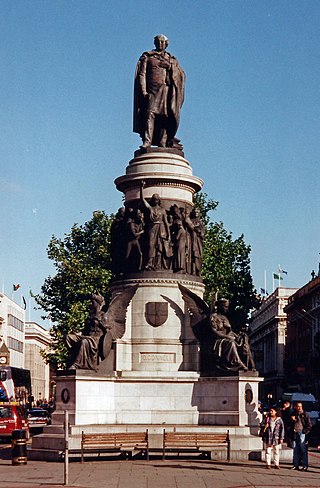
Daniel(I) O’Connell, hailed in his time as The Liberator, was the acknowledged political leader of Ireland's Roman Catholic majority in the first half of the 19th century. His mobilisation of Catholic Ireland, down to the poorest class of tenant farmers secured the final instalment of Catholic emancipation in 1829 and allowed him to take a seat in the United Kingdom Parliament to which he had been twice elected.

O'Connell Street is a street in the centre of Dublin, Ireland, running north from the River Liffey. It connects the O'Connell Bridge to the south with Parnell Street to the north and is roughly split into two sections bisected by Henry Street. The Luas tram system runs along the street.

Thomas Osborne Davis was an Irish writer; with Charles Gavan Duffy and John Blake Dillon, a founding editor of The Nation, the weekly organ of what came to be known as the Young Ireland movement. While embracing the common cause of a representative, national government for Ireland, Davis took issue with the nationalist leader Daniel O'Connell by arguing for the common ("mixed") education of Catholics and Protestants and by advocating for Irish as the national language.

Francis Blackburne PC (Ire) KS was an Irish judge and eventually became Lord Chancellor of Ireland.
The Irish Conservative Party, often called the Irish Tories, was one of the dominant Irish political parties in Ireland in the 19th century. It was affiliated with the Conservative Party in Great Britain. Throughout much of the century it and the Irish Liberal Party were rivals for electoral dominance among Ireland's small electorate within the United Kingdom of Great Britain and Ireland, with parties such as the movements of Daniel O'Connell and later the Independent Irish Party relegated into third place. The Irish Conservatives became the principal element of the Irish Unionist Alliance following the alliance's foundation in 1891.

Abraham Brewster PC (Ire) was an Irish judge and Lord Chancellor of Ireland.

Franc Sadleir [formerly Francis] was an Irish academic who served as the 28th Provost of Trinity College Dublin from 1837 to 1851.
Michael Slattery (1783–1857) was a Roman Catholic clergyman who served as the Archbishop of Cashel & Emly from 1833 to 1857.

Samuel Wensley Blackall was an Irish soldier and politician, who was the second Governor of Queensland from 1868 until he died in office in 1871.
Feardorcha Ó Conaill or Frederick William O'Connell was a Church of Ireland clergyman, writer, and translator to and from Irish often under the pen name Conall Cearnach. He is known especially for editing the work of Peadar Ó Laoghaire.

Charles Brownlow, 1st Baron Lurgan PC, was an Anglo-Irish politician who sat in the House of Commons from 1818 to 1832, during which time he recanted his Orange Order opposition to Catholic emancipation. He was raised to the peerage in 1839.
Philip Cecil Crampton PC was a judge, politician and Solicitor-General for Ireland. He was also a noted supporter of the cause of total abstinence from alcohol.
Joseph Aldrich Bermingham was an eminent Irish Anglican priest.
John Sheehan (1812–1882) was an Irish journalist, writer and barrister.
Thomas Perceval Magee (1797-1857) was an Anglican Archdeacon in Ireland in the late nineteenth century: in 1831 Daniel O'Connell stated in the British House of Houses that he held 11 livings.

North Earl Street is a short stretch of city-centre street located on Dublin's Northside and formerly a major shopping area. It runs from Marlborough Street in the west to O'Connell Street beside the Spire.
Garrett Standish Barry was a Liberal Member of Parliament for County Cork in the Parliament of the United Kingdom from 1832 to 1841. An extremely popular figure, Standish Barry retired to give his seat to "The Emancipator" Daniel O'Connell, who had failed to retain his seat in Dublin.
Robert Vickers Dixon was an Irish academic and clergyman who served as Erasmus Smith's Professor of Natural and Experimental Philosophy at Trinity College Dublin (TCD) from 1848 to 1853, and much later as Archdeacon of Armagh from 1883 to 1885.
Thomas Kingsbury was an Anglican priest in Ireland during the 19th century.
John Quarry was Archdeacon of Cork from 1894 until 1899.











